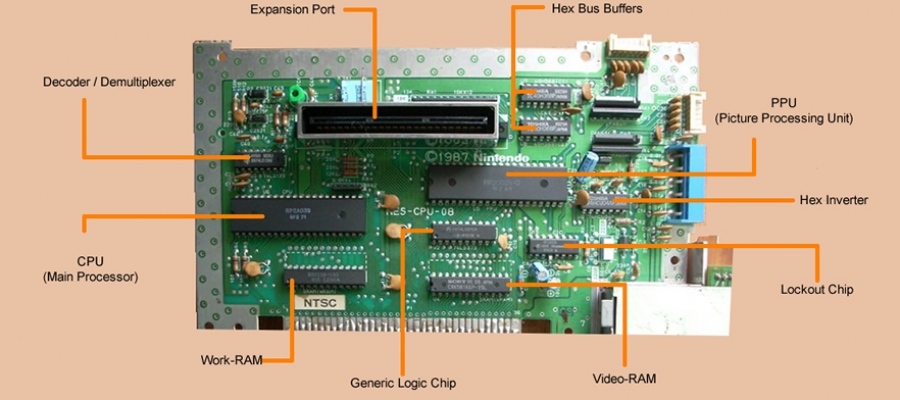

Ever wondered whats inside your original Nintendo NES console? In this post we go over each main chip and explain in simple terms what each of them do...
The Famicom/NES wasn't the first console to appear to the public, but it was definitely the console that changed the game forever! And nearly 40 years after its release, its still a console that many people enjoy playing to this day!
There are many websites out there dedicated to the technical side of the console, but its not easy to locate an explanation of the inner workings thats written in a simplistic form. So hopefully we can achieve that today, and help those interested learn a little more about the 8-bit machine.
We will start by showing an image of the internals of the Nintendo NES console, and then we will list out what each of the main chips do. The image used is from a US NTSC board, which uses the same layout as the UK & European PAL version of the system. The area we are viewing is the bottom side of the consoles motherboard, and the row connector we can see at the bottom of the image is where the cartridge slot connects to.

CPU/APU - The CPU stands for Central Processing Unit and is more commonly referred to as the "processor". It is essentially the brains of the unit and controls the system. Nintendo used a Ricoh 6502 CPU that was customised to include integrated sound referred to as the Audio Processing Unit. An idea which would allow Nintendo to copyright the chip and take extra precautions over people creating clones of the system.
PPU - The Picture Processing Unit handles all the graphical processes for the console, and makes everything display in its correct manor. The chip also creates a composite TV signal which is then fed out to the red/white connectors on the side of the console, as well as to the RF output connection seen on the back of the console. As the chip only outputs Composite signal, a separate RF modulator is used to create a standard Ariel TV signal.
VRAM - The Video Memory chip is what stores certain graphical data in order to display it to the screen in a seamless motion. Without this chip games would have a kind of buffering effect when a new enemy or object is drawn to screen.
WRAM - The WRAM Processing Memory chip is similar to the Vram chip, except its purpose is to write data used for the CPU that is received from the Cartridge and control pads.
Lockout Chip - The CIC chip is what stores Nintendos encryption code, and its uses are to decide if a game cartridge is genuine or not, as well as checking for the games region code. It works as a type of Rainbow Table that reads a code on the cartridges CIC chip and decrypts it. If the unencrypted code is valid the cartridge tells the CPU the game is official and can load. (this is actually a very neat operation and one that ill go into in more depth in another post)
Expansion Port - Unused - Certain Japanese Famicom games (Castlevania) used separate sound channels in order to deliver a better musical experience. This port was also to enable the microphone as seen on the Famicoms 2nd control pad. Its unsure why the expansion port was added into the NES console, as the port was blocked off by the casing.
Generic Logic Chip - This chip helps the necessary data flow to the PPU and just makes everything handle more efficiently.
Hex Buffer/Inverter & Decoder Chips - General electronic chips. Used to help make everything work.
So there we have it, a simplistic breakdown of the main chips inside a NES console. Hopefully this has made things a little easier to understand than the usual tech minded posts that are found on the www. But if your seeking more indepth info then please head over to the NESDevWiki page for plenty more info. And please stay tuned for the explanations on the internals of a NES cartridge, coming shortly.
If youd like to see some Famiclone teardowns then please take a look at our Attacking The Clones YouTube videos.
Original NES motherboard image taken from HERE.